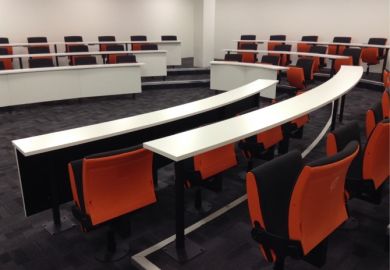Expensive campus upgrades may have a limited effect on learning unless academics are given time to adapt their teaching to new learning spaces, a conference has heard.
Frank Coton, vice-principal for academic and educational innovation at the University of Glasgow, told Times Higher Education’s Teaching Excellence Summit that his institution was currently converting many of its lecture halls into “active learning spaces”, which contained fewer seats but more space for tables to enable student discussions.
When its new £91 million Learning and Teaching Hub building opens in August 2019, the university will have 50 flexible learning spaces, including a 500-seat lecture hall, representing about 35 per cent of its centrally bookable rooms. With a further £2 million a year due to be spent on converting older lecture halls as part of a £1 billion, 10-year campus renovation plan, the majority of its teaching rooms will eventually be flexible spaces.
However, Glasgow is highly aware of the need to support staff as they adopt new teaching methods, including the use of electronic clickers and small group work, that will be made possible by the new spaces, Professor Coton explained at the summit, held at the Scottish university.
“Although it costs a lot of money, changing the physical spaces is actually relatively easy to do – the biggest challenge is taking colleagues on a journey with us, where they evolve their approach to teaching,” Professor Coton told THE.
In addition to introducing new technology and the so-called “flipped classroom” into their teaching methods, academics would need to adapt to a different “power balance” within the classroom, where students would be invited to interrogate lecturers’ ideas more extensively, he said.
“Within the lecture space, academics are completely in control – it’s a scenario they control, and many have never put themselves in a position of vulnerability, where it’s possible they don’t know an answer,” said Professor Coton.
He hoped that staff would adopt teaching models used at Nanyang Technological University, in Singapore, where lectures began with multiple-choice questions, allowing staff to focus on areas of knowledge that had not been properly understood. However, Glasgow had noted the experience of McGill University, in Canada, where staff had initially been resistant to using the new flexible spaces after being offered “training” by their institution, said Professor Coton.
“McGill found that if you provided training in these spaces, you should not call it ‘training’ because staff did not turn up,” Professor Coton told delegates.
“If you call it a meeting of staff interested in this, then people will come along,” he added, stating that it was better for lecturers to see the benefits enjoyed by other staff using these spaces, rather than requiring staff to use the new areas.
“At this point, you get a ripple effect where staff can see the potential benefits for their own teaching,” he said.
jack.grove@timeshighereducation.com
Watch the summit debate chaired by Alison Johns, chief executive of Advance HE, with panellists Sian Bayne, professor of digital education, University of Edinburgh; Frank Cotton, vice-principal for learning and teaching, University of Glasgow; Lauren Herckis, Simon Initiative research scientist, Carnegie Mellon University; and Han van Krieken, rector magnificus, Radboud University.
Register to continue
Why register?
- Registration is free and only takes a moment
- Once registered, you can read 3 articles a month
- Sign up for our newsletter
Subscribe
Or subscribe for unlimited access to:
- Unlimited access to news, views, insights & reviews
- Digital editions
- Digital access to THE’s university and college rankings analysis
Already registered or a current subscriber?






